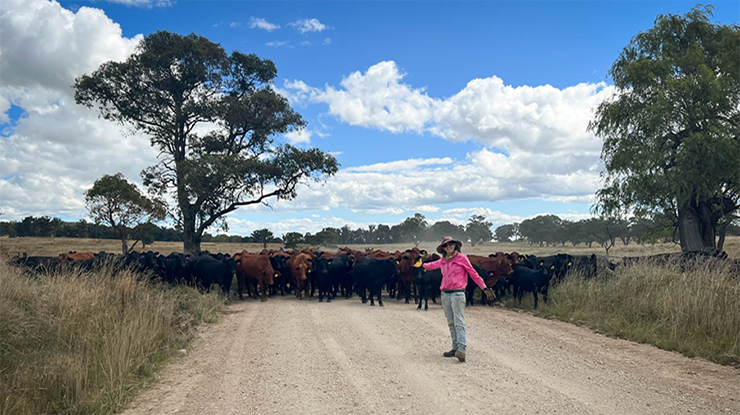Natural capital grows on-farm productivity
19 January 2023
 Susan Newey is drawing on research insights to manage the natural capital on her Armidale property.
Susan Newey is drawing on research insights to manage the natural capital on her Armidale property.
A passion for the Australian landscape is in Susan Newey’s genes.
She grew up on the northern Queensland cattle station ‘Myrrlumbing’ where her amateur botanist mother and ornithologist father, Judy and Sandy Hunt, instilled in her a love of the land and Australian flora and fauna.
Just as importantly, they also taught her about the importance of caring for the land to their farm’s commercial success.
Now running her own cattle at ‘Olmo’, north of Armidale, Susan’s passion for continuing to learn about her property and how to best care for it was the driver to sign up for the pilot phase of Farming for the Future.
MLA is a partner in this multi-year study – the biggest of its kind in the world – which aims to conduct research at thousands of Australian farms to quantify the contribution of different types of natural resources – the ‘natural capital’ – to their profitability.
With this insight, producers will be able to make more informed decisions than ever before about how to best manage their land for both its health and farm profit.
Data backs up assumptions
While producers have long known a farm’s natural capital will influence productivity and profitability, this relationship has yet to be properly quantified at scale.
Farming for the Future is looking to change that, through research and the development of tools for producers to bring their natural capital onto their farm balance sheets.
The ability to audit her property over time to ensure it was moving in the right direction to be more diverse and resilient was a leading motivation for Susan to participate in the project.
“Farming for the Future is an unbelievable opportunity to have the natural capital on our property scientifically measured, rather than just working with gut feel,” she said.
“Having natural capital figures of our property is beyond exciting.”
Planning for the future
Susan also has one eye on the future for both her property and her family’s connection with the land.
“We also know that new revenue streams are opening up to producers, particularly in the carbon credits space,” she said.
“Tapping into these additional revenue streams might give our family more options when thinking about how we pass Olmo onto the next generation, particularly if not all of them want to stay on the land.”
At a high level, the research process involves scientists taking measurements and records at multiple points in time across the property. Assessments of plant and bird species using approaches being tested by the La Trobe University’s Farm-Scale Natural Capital Accounting project have already taken place at Olmo, with soil and insects the next areas of particular focus.
“Joining the ecologists and other scientists while they have undertaken their work at Olmo has been an amazing experience,” Susan said.
“The work they do is to a rigorous scientific standard. In spending time with them, I’ve learnt a lot about Olmo, such as discovering plant species I had no idea existed on our property, which has been so rewarding.”
Next steps at Olmo
Susan is now keen to see how the project interprets the data from Olmo with the support of tools and experts.
“I’m keen to understand how our approach to farm management stacks up against others, learn from other producers and, ultimately, make better and more informed decisions at Olmo.”
Play a part
For other producers who are thinking of participating in the Farming for the Future research, Susan’s advice is to get involved – see project contact below.
“Most producers are passionate about the land, and this project is an opportunity to understand where there are better, easier and more profitable ways of managing land than the high-input system we have slipped into.
“In doing so, we can ensure that our children take over sustainable farming businesses with high levels of natural capital that will support them well into the future.”
Lessons learnt
|


